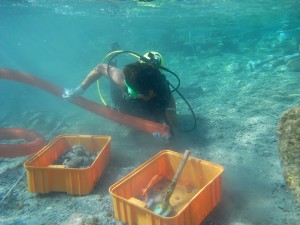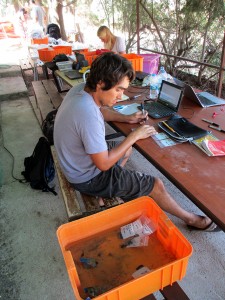(guest post by James Gross)
At 19 I am the youngest member of the harbor team at Burgaz this season (and perhaps ever). I arrived in July with little experience of real archeological fieldwork but a lot of energy and excitement. I can proudly say now as we near the end of the project that I have learned a lot, more than I could have hoped. In L2 I became familiar with using water pumps and dredges and in L1 I helped with the difficult task of digging by hand in shallow water. While excavating I learned a number of archeological skills related to identifying stratigraphy, finds, and architecture. Beyond fieldwork, I also began the process of learning to understand and interpret finds.
Through one of my daily tasks–pottery recording and quantification–and through conversations with the team, I learned to appreciate the many tiny and seemingly insignificant sherds around L1. By counting and weighing every sherd for quantification, I realized that sherds could be used for far more than determining the date, typology or origin of diagnostic finds. While one tiny sherd may say little, when it is coupled with all the others from a stratigraphic layer, trench, harbor, or even site, that larger grouping can provide important insight into how and for what purpose an area was used.
With its layers that were often completely devoid of finds, L2 stood in stark contrast to the thousand of sherds and the discovered in L1. When I was digging in L2 for the first few weeks I was initially disappointed at how little we were finding. At that moment I learned the value that nothing can have. From those layers with no finds we could pinpoint exactly what layers represented the site’s occupation; we could then speculate why and how the harbor was constructed and what purpose it served.
Now, nearing the end of August and the end of my time at Burgaz, I am happy to be the youngest member of the team. I have had an experience few can claim, and I am confident I have made a good beginning towards learning to be a true archeologist.



